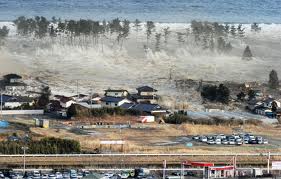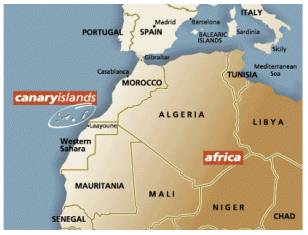
 After the massive earthquake of 2004 that impacted Indonesia and the massive earthquake of March 2011 that has now been experienced by Japan, the word “tsunami” has entered the world’s vernacular. As a geoscientist, this is a word that I am very familiar with but it is not one that was generally known outside of the geological community, until the massive impacts of the two aforementioned earthquakes.
After the massive earthquake of 2004 that impacted Indonesia and the massive earthquake of March 2011 that has now been experienced by Japan, the word “tsunami” has entered the world’s vernacular. As a geoscientist, this is a word that I am very familiar with but it is not one that was generally known outside of the geological community, until the massive impacts of the two aforementioned earthquakes.The word “tsunami” is a Japanese word meaning “harbour” (tsu) and “wave” (nami). Tsunamis are a series of water waves which are created when a large volume of water is displaced usually in the ocean, however, they can occur in large lakes. Tsunamis are usually generated as a result of a subsea earthquake, volcanic eruptions, landslides both above and below water and meteorite impacts. These wave forms have nothing to do with normal tides despite the fact that they are often referred to as "tidal waves".
The Ring of Fire surrounding the Pacific Ocean has experienced a great number of tsunamis, both large and small, over the millennia primarily because the area is very active tectonically. Abundant earthquakes related to movement of the crustal plates of the earth result in displacement of the floor of the ocean which, in turn, displaces the overlying water. Generally, a tsunami created by an earthquake is not noticed when out at sea, it is only when the base of the wave impacts the bottom of the ocean near shorelines that the amplitude (height) of the wave grows to the point where water is forced far inland.
One area of the world that feels the impact of very few tsunamis is the rim of the Atlantic Ocean. Because the margins of the Atlantic are passive (there is very little tectonic activity like vulcanism and earthquakes), the ocean floor is rarely displaced violently. Having said that, there is one potentially massive tsunami that could change the entire configuration of the most highly populated portions of the Atlantic coast in the future.
Dr. Steven Ward from the Institute of Geophysics and Planetary Physics at the University of California and Dr. Simon Day from the Department of Geological Sciences at University College in London, U.K. published a paper in 2001 in the American Geophysical Union Journal. This paper, entitled “Cumbre Vieja Volcano – Potential collapse and tsunami at La Palma, Canary Islands” studied the potential for a mega tsunami intitiated by the structural failure and collapse of the west flank of the Cumbre Vieja volcano on the Island of La Palma in the Canary Islands off the west coast of Africa. Here’s a map showing the location of the Canary Islands, off the west coast of Morocco:
Here is a map showing the Canary Islands in detail with La Palma Island located furthest to the west:
In their paper, the authors note that massive failures of the flanks of oceanic volcanos such as those found in Hawaii are both spectacular and not as rare as was previously thought. Some of these historic collapses were massive with up to 5000 cubic kilometres of material being shed as the flank of the volcano collapsed into the sea (that’s a block of rock 17 kilometres by 17 kilometres by 17 kilometres). When the block collapses into the ocean, it displaces a massive volume of water resulting in the creation of a tsunami.
The Cumbre Vieja volcano has been very active over the past 125,000 years. The island that it is located on, La Palma, rises roughly 2000 metres above sea level with average flank slopes of 15 to 20 degrees. Historically, there have been at least a dozen major collapses from the flanks of the volcano into the Atlantic Ocean over the past several million years. An eruption of Cumbre Vieja in 1949 resulted in the development of a 4 kilometre long and 4 metre high surface rupture that could represent the initial surface expression of a detachment fault that could ultimately lead to slide block failure. Sliding along the fault could be triggered by a future eruption of the volcano, resulting in failure of the flank of the volcano. From the geological evidence, it appears that the unstable block could be as long as 15 to 20 kilometres wide and 15 to 25 kilometres long with an undetermined thickness that should fall between 1 and 2 kilometres. With those dimensions, the unstable block should fall in the range of 150 to 500 cubic kilometers, a rather massive chunk of stone!
Using linear wave theory, Ward and Day calculated that, in the worst case scenario, the displacement of a 500 cubic kilometer block, 25 kilometres long, 15 kilometres wide and 1400 metres thick, will cascade down the slope and into the offshore for 60 kilometres until it reaches the flat ocean bottom at 4000 metres depth after having travelled at about 100 metres per second. (223 miles per hour).
After a very long 10 minutes has passed, the displaced material has reached the end of its journey and the slide is over. By that time, the tsunami created by the displaced material is 250 kilometres in diameter and has waves that are several hundred metres high. Spain and England will experience waves of 5 to 7 metres (16 to 23 feet) in height because the wave train is partially deflected by La Palma Island. Newfoundland, Canada, located in the Northwest Atlantic, could experience tsunami wave heights of 10 metres (33 feet) and the north shore of South America could experience waves of between 15 and 20 metres (49 and 66 feet) in height. Waves reaching the Cape Canaveral area of Florida could reach between 20 and 25 metres (66 and 82 feet) in height. Here’s the tsunami model:
While scientists agree that the frequency of these massive collapse and tsunami events are extremely rare, in light of the recent high magnitude earthquakes in both Japan and Indonesia, one should never say never. The impact on the coastal population and infrastructure, specifically along the eastern coast of the United States would be massive. Should such an event take place, the loss of life would be staggering, most particularly because tens of millions of people live at or very slightly above sea level.
Click HERE to read more of Glen Asher’s columns.
Article viewed at: Oye! Times at www.oyetimes.com
You can publish this article on your website as long as you provide a link back to this page.




Very nice summary of the threat. For more details on Prof Ward’s more recent computer models and animations, as well as a new proposal to reduce the unstable block with mining equipment, please see LegendaryPharma.com/jdf/tsunami.html